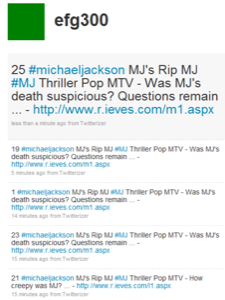Has Twitter spam gotten a little out of hand? According to today’s top story on Techmeme, it has. Apparently, marketers are calling for Twitter to filter out spam and other adult content from the microblogging service. You know, so their all-important tweets about the products and services they’re pushing don’t have to share the same web space as that other nasty stuff. But fighting actual spammers is still relatively easy for an end-user: it’s called the “unfollow” button.

Ironically, if anyone’s to blame for spamming our Twitter timelines, it’s the marketers themselves. They’ve managed to trick our friends into spamming us with their messages instead.
If You’re Getting Real Spam, Blame Yourself
We’re not sure where anyone, marketer or not, gets off telling Twitter that it’s their responsibility to filter the content that flows through their service mainly because Twitter is already doing so. The company itself currently addresses the spam issue by providing an @spamaccount where you can report spammers and other abusers in the Twittersphere. If the account in question is indeed a spammer, Twitter boots them from the service. That sounds good to us. Simple and effective…at least for the end user. (It’s probably a nightmare to deal with at Twitter HQ).
Of course, Twitter doesn’t want their service overrun by spammers – no one would. However, they’re probably more concerned with wasting their resources to support these fake accounts than they are with the annoyance it causes for their users. But do they have it under control? Perhaps not – fighting spam is sort of like fighting computer viruses. You block one and someone makes a new one. The same goes for spammers – kill one spammer and another appears to take his place. It’s an ongoing fight, not a plague that can be wiped out overnight through some magic filter.
Besides, what you consider spam, I may consider “valuable information about a product.” Probably not, but there is a gray area there that has to be taken into consideration. Some spam is out-and-out spam, but other stuff may just be “hot deals” from a legitimate company. However, if you didn’t want to see said hot deals, you might consider them spam. Still, how would you see them unless you actually followed that account to begin with? Or maybe you turned on auto-follow using a service like SocialToo? If that’s the case, it’s a little ridiculous for you to get annoyed when half your timeline turns into a slew of “buy this” messages – you only have yourself to blame for that.
Where Actual Spam Hurts Us
The only place that honest-to-goodness spam can really affect you on an everyday basis is not in your own personal timeline of friends’ tweets, but when viewing a trending topic’s stream or when doing a keyword search. In these cases, spammers hijacking a currently popular hashtag may show up in the timeline, potentially diluting the results with irrelevant information. For this reason alone, we support Twitter’s spam-fighting efforts.

Even More Dangerous? “Tweet to Win”
What’s actually more concerning than spam, however, is the new trend we’ll call “tweet to win.” Legitimate companies have begun using Twitter to promote a message – essentially an advertisement about their business’ offerings. To cajole twitizens into “spamming” their followers in this way, they’re offering prizes or the chance to win prizes in return. (Full disclosure: this author did this once and still regrets it).
This situation hasn’t gotten out of hand just yet, but it seems like it’s only a matter of time before it does. Because really, how many of you could resist yourselves if all of a sudden a company started giving away free Macbook Pros? Oh, apparently not too many of you because you’ve already spammed up trending topics today with #moonfruit. What’s Moonfruit? Why, it’s a company that’s giving away a free Macbook Pro every day for 10 days. Is this a brilliant social media promotion (as Adam Ostrow of Mashable claims) or just a new, inventive way to junk up the twitterstream with advertisements? We think it’s closer to the latter.

The only consolation in this particular case is that Moonfruit doesn’t care what your tweet says, so it can just be appended to any ordinary tweet. That’s not usually the case – most companies provide a message for you to re-tweet.
What’s frightening about this “it’s not spam, it’s a message from your friend” is that it’s really not. My friend isn’t actually telling me that Moonfruit is this great new company they have just heard about and that I really have to check out. This isn’t a word-of-mouth recommendation – my friend just wants to win a new laptop. They know this, I know this, and the company knows this. And that makes the message just as spammy to me as any other in-stream tweet from an actual spammer.
So, what can be done? Well sure, I could unfollow that so-called friend, but why would I? It’s not like they do this regularly and 99% of the time, I like what they have to say. But while one day that friend is tweeting to win a Macbook, another may be tweeting to win something else. Even if only a small percentage of an ever-shifting group of my friends tweeted a promotional message every day, it would be enough to junk up my timeline.
Sadly, that’s one kind of spam that Twitter can’t really block. And neither can I.





















